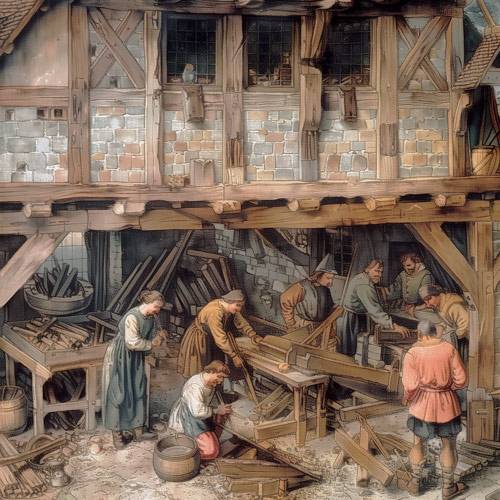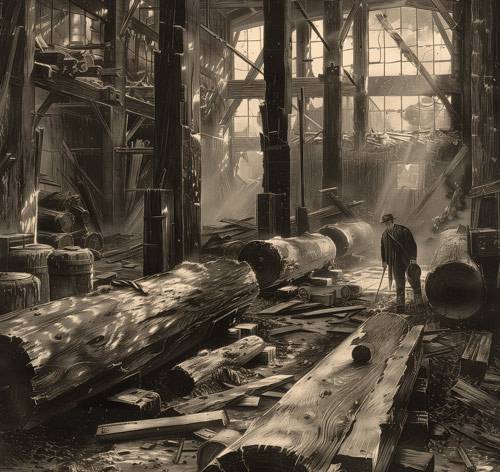The importance of wood in antiquity
In ancient civilizations, wood played a crucial role in the construction of buildings and other structures. It was used for the construction of temples, palaces, bridges and ships. Wood also had great religious and cultural significance. In many cultures, sacred rituals were performed with the help of wooden objects, such as offerings or totems.

The use of wood in the Middle Ages
In the Middle Ages, wood played a central role in the architecture of the time. Many medieval buildings were constructed from wooden beams that were joined together to create stable structures. In addition, carpentry and joinery techniques developed further in the Middle Ages, which led to improved processing of the material.

The Renaissance and the rise of wood as a decorative material
During the Renaissance, wood-based decorative crafts experienced a boom. Wood carving and turning became an art form that was widely used in architecture and furniture design. Wood was used for elaborate decorations on buildings, furniture and other objects.
The influence of the industrial revolution on wood processing
With the industrial revolution, new mass production techniques were developed, which also revolutionized the processing of wood. New wood-based materials such as plywood and chipboard emerged, offering a cheaper alternative to solid wood.

The development of wood as a building material in the 20th century
In the course of the 20th century, wood was also used in modern architecture. Innovative techniques for using wood were developed, such as Ghulam or glued laminated timber trusses to bridge large spans.
The environmental benefits of wood as a sustainable building material
Wood has many environmental advantages over other building materials. It is a renewable raw material and helps to reduce carbon emissions as it binds CO₂ from the atmosphere as it grows.
Here are a few properties of wood, especially as a building material:
| Type of wood | Density (kg/m³) | Strength (N/mm²) | Modulus of elasticity (N/mm²) |
|---|---|---|---|
| Spruce | 450–550 | 30–50 | 8.000-12.000 |
| Pine | 400–550 | 30–50 | 8.000-12.000 |
| Beech | 650–800 | 50–80 | 12.000-16.000 |
| Oak | 650–900 | 60–100 | 12.000-16.000 |
The importance of wood in furniture production
Wooden furniture has a long tradition in furniture manufacturing and is known for its durability and resistance to wear and tear compared to other materials such as plastic or metal.
The use of wood in art and design
Wood is an extremely versatile material that is ideal for artistic expression. It is used in sculpture, carving and joinery to create unique works of art.
The importance of wood in the manufacture of musical instruments
Wood plays a crucial role in the manufacture of musical instruments. Its unique properties contribute to the sound quality and make it the preferred material for string, wind and percussion instruments.
The future of wood as a sustainable building material
The future of wood as a building material looks promising. There are already new innovations in wood processing and technology that could lead to even more efficient uses.

Conclusion
In summary, wood has a long history as a building material and will continue to play an important role in architecture, design and sustainability. Its versatility, environmental friendliness and aesthetics make it an indispensable material for many applications.
Wood not only offers a natural and warm atmosphere, but also high strength and durability. It is also a renewable raw material that conserves resources when properly managed and processed. The variety of wood types and processing options makes it possible to create individual and unique designs. All in all, wood is not only a timeless and aesthetic material, but also a sustainable choice for the future.
FAQs
What is wood?
Wood is a natural material that is obtained from the trunks and branches of trees. It is an essential raw material for the manufacture of furniture, paper, construction timber and many other products.
How was wood used in ancient times?
In ancient times, wood was used to build houses, ships and furniture. It was also used as fuel and for the manufacture of tools and weapons.
How has the use of wood changed over time?
The use of wood has changed considerably over the course of time. While in the past it was mainly used to build houses and ships, today it is also used to make paper, furniture, packaging and many other products.
How is wood used in modern architecture today?
In modern architecture, wood is often used as a sustainable building material. It is used to build houses, bridges and other structures. Wood is also typically used in interior design to create a warm and natural atmosphere.
What are the advantages of using wood?
The use of wood has many advantages. It is a renewable raw material that binds CO₂ during the manufacture of products. Wood is also a very versatile material that is suitable for many applications. It also has a natural and warm appearance that appeals to many people.
What are the disadvantages of using wood?
The use of wood also has some disadvantages. If not cared for properly, it is susceptible to moisture and pests, which can lead to damage. In addition, the manufacture of wood products in large quantities can lead to deforestation, which can have a negative impact on the environment.





